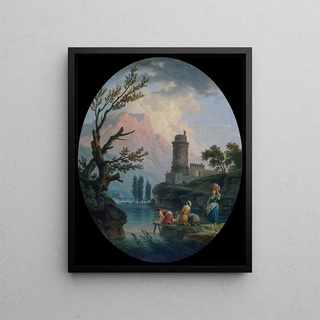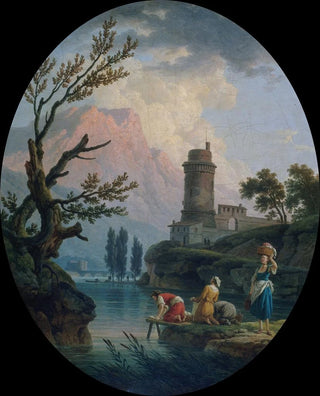Painting Landscape with Laundresses - Claude-Joseph Vernet | Art print Source: Tableau Paysage avec lavandières - Claude-Joseph Vernet | Reproduction


View from behind

Frame (optional)
In the enchanting world of 18th-century French painting, the art print "Paysage avec lavandières" by Claude-Joseph Vernet stands out for its ability to capture the simple beauty of everyday life. This piece depicts a peaceful scene where women are busy by the riverbank, illustrating not only a moment of work but also a harmony between man and nature. The soft light bathing the composition, along with the delicate colors, immerses the viewer in a serene and contemplative atmosphere, reminiscent of the bucolic landscapes of the period.
Style and uniqueness of the work
Vernet's style is characterized by meticulous attention to detail and an impressive mastery of light. In "Paysage avec lavandières," shades of green and blue blend gracefully, creating a depth that draws the eye beyond the canvas. The washerwomen, depicted with remarkable delicacy, are both central figures and integrated elements within the surrounding landscape. The artist manages to balance human representation with the majesty of nature, demonstrating a sensitivity that echoes the tradition of idealized landscapes. This art print is a celebration of rural life, where each brushstroke reveals a story, an emotion, and a deep connection between the characters and their environment.
The artist and his influence
Claude-Joseph Vernet, born in 1714 in Avignon, is one of the most emblematic painters of his time, recognized for his marine landscapes and scenes of daily life. His work is part of an artistic movement that values nature and simple living, while incorporating elements of mythology and historical narratives. Vernet successfully influenced many artists, both through his realistic approach and his keen sense of composition. His ability to depict light and atmosphere has left an indelible mark on landscape painting, inspiring generations of painters to explore the relationships between humans and their environment. "Paysage avec lavandières" is a perfect example of this influence, where the simplicity of the subject transforms into a work of great visual and emotional richness.
A decoration

Matte finish

View from behind

Frame (optional)
In the enchanting world of 18th-century French painting, the art print "Paysage avec lavandières" by Claude-Joseph Vernet stands out for its ability to capture the simple beauty of everyday life. This piece depicts a peaceful scene where women are busy by the riverbank, illustrating not only a moment of work but also a harmony between man and nature. The soft light bathing the composition, along with the delicate colors, immerses the viewer in a serene and contemplative atmosphere, reminiscent of the bucolic landscapes of the period.
Style and uniqueness of the work
Vernet's style is characterized by meticulous attention to detail and an impressive mastery of light. In "Paysage avec lavandières," shades of green and blue blend gracefully, creating a depth that draws the eye beyond the canvas. The washerwomen, depicted with remarkable delicacy, are both central figures and integrated elements within the surrounding landscape. The artist manages to balance human representation with the majesty of nature, demonstrating a sensitivity that echoes the tradition of idealized landscapes. This art print is a celebration of rural life, where each brushstroke reveals a story, an emotion, and a deep connection between the characters and their environment.
The artist and his influence
Claude-Joseph Vernet, born in 1714 in Avignon, is one of the most emblematic painters of his time, recognized for his marine landscapes and scenes of daily life. His work is part of an artistic movement that values nature and simple living, while incorporating elements of mythology and historical narratives. Vernet successfully influenced many artists, both through his realistic approach and his keen sense of composition. His ability to depict light and atmosphere has left an indelible mark on landscape painting, inspiring generations of painters to explore the relationships between humans and their environment. "Paysage avec lavandières" is a perfect example of this influence, where the simplicity of the subject transforms into a work of great visual and emotional richness.
A decoration
12,34 €






